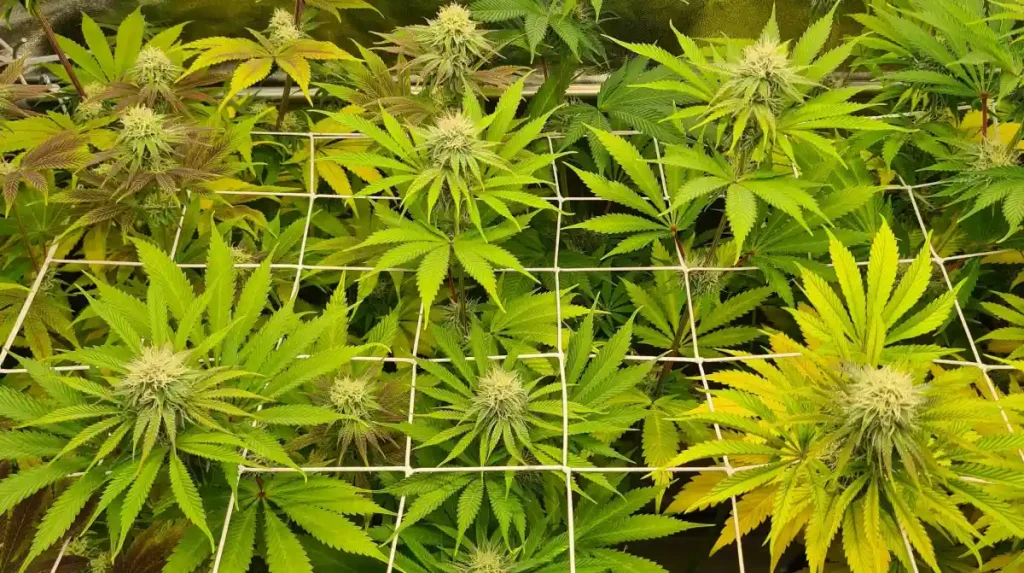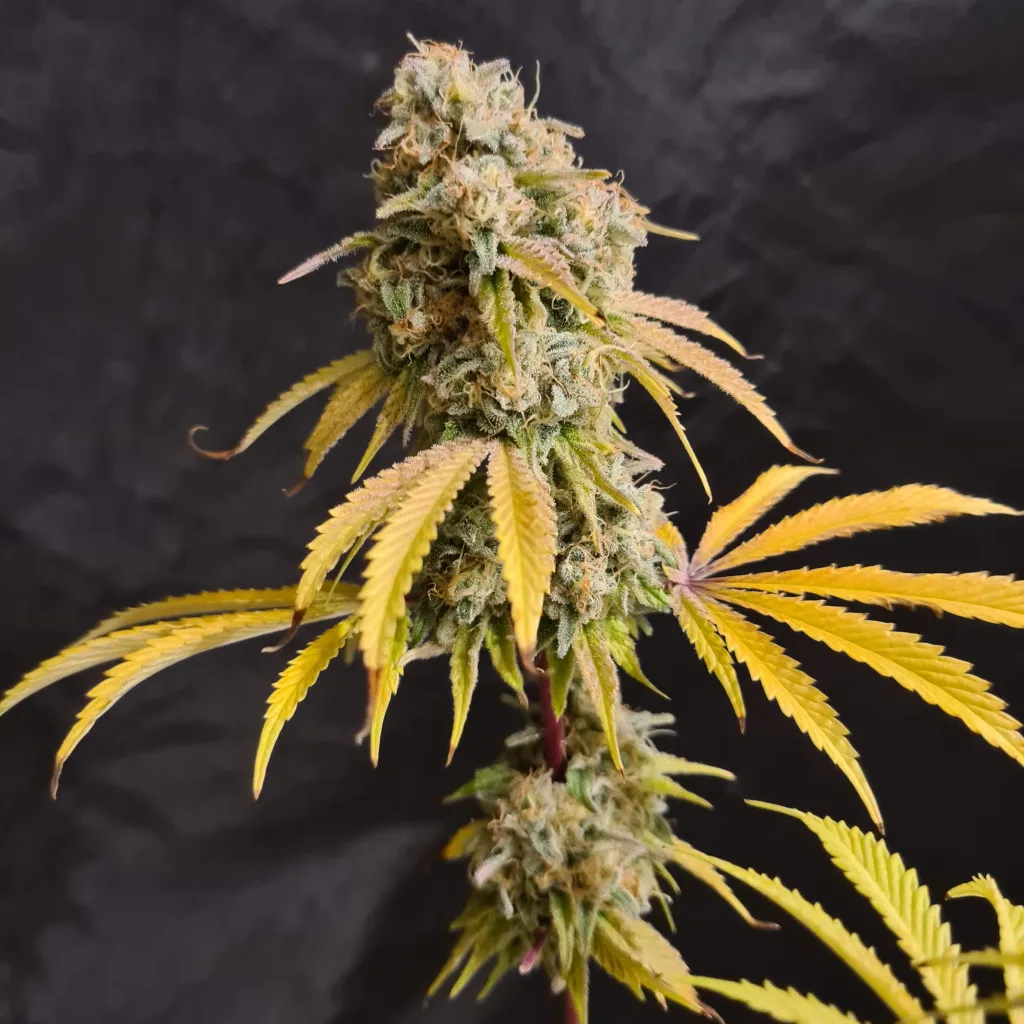Cloud Walker Strain is a sativa-dominant hybrid known for its tropical lineage and uplifting effects. Originating from a cross between Punta Roja and Mendo Breath F2, this strain boasts a unique flavor profile of citrus, tropical fruit, and earthy undertones. With THC levels often reaching 22-26%, Cloud Walker provides an energetic yet balanced experience, making it ideal for creative activities or daytime use. Its visually striking buds feature vibrant green hues, orange pistils, and a frosty layer of trichomes, making it as aesthetically pleasing as it is potent.
Environmental Requirements for Growing Cloud Walker Strain
Cloud Walker thrives in stable environments where temperature and humidity are carefully controlled. Daytime temperatures between 70°F and 80°F (21°C to 27°C) and nighttime drops to 65°F (18°C) are ideal for robust growth. Humidity should range from 50-60% during vegetative stages and decrease to 40-50% during flowering to prevent mold. Adequate airflow and proper ventilation are critical to maintaining plant health and avoiding common issues like mildew or stagnant air.
Outdoors, this strain prefers sunny, Mediterranean-like climates with minimal fluctuations in weather. The plants benefit from being grown in nutrient-rich, well-drained soil, supplemented with organic compost for added fertility. If grown in unpredictable climates, consider using greenhouses or protective covers to shield them from extreme conditions. Proper spacing between plants ensures good airflow, reducing the risk of pest infestations and encouraging healthy development.
Setting Up The Growing Cannabis Space
Indoor Cannabis Cultivation
When cultivating Cloud Walker indoors, a well-equipped grow tent with full-spectrum LED lighting is ideal. Maintain a light schedule of 18/6 during the vegetative phase and switch to 12/12 for flowering to promote bud formation. The strain thrives in soil enriched with nutrients or in hydroponic setups that offer precise control over feeding. Regular monitoring of pH levels (6.0-6.5 for soil, 5.5-6.0 for hydroponics) prevents nutrient lockout and promotes healthy growth.
Temperature and humidity control are vital in indoor environments to replicate the strain’s preferred conditions. Use fans and carbon filters to maintain airflow and manage odors effectively. Low-stress training (LST) can be applied to maximize light penetration, encouraging even growth and larger yields. Consistent maintenance and observation are key to achieving optimal results.
Outdoor Cannabis Cultivation
Outdoors, Cloud Walker thrives in areas with long daylight hours and fertile soil. Position the plants where they can receive at least 8 hours of direct sunlight daily for optimal photosynthesis. Companion planting with herbs like basil or marigolds can help deter pests naturally and enhance the soil ecosystem. Regular watering and feeding with organic fertilizers ensure the plants reach their full potential in size and yield.
Propagation and Germination of Cloud Walker Strain
Start the germination process by soaking the seeds in water for 12-24 hours until they develop tiny taproots. Transfer the germinated seeds to moist paper towels and store them in a warm, dark location to encourage sprouting. Once the taproots are well-established, carefully plant them in small pots with seedling soil to promote healthy root development. Provide gentle lighting and maintain humidity levels of 60-70% during this early stage to ensure success.
As seedlings emerge, they require consistent care to transition smoothly into the vegetative phase. Avoid overwatering, as excess moisture can cause damping-off or root rot. Once the seedlings have outgrown their pots, transplant them into larger containers or outdoor soil to give their roots ample space. Proper handling during this phase sets the foundation for vigorous and productive plants.
Vegetative Phase of Cloud Walker Strain
During the vegetative stage, Cloud Walker Strain exhibits rapid growth. Provide nitrogen-rich nutrients to support foliage development. Prune lower leaves to enhance airflow and light penetration. Maintaining a consistent temperature and humidity level ensures optimal growth. This stage typically lasts 4-6 weeks, depending on the desired plant size.
Flowering Phase of Cloud Walker Strain
The flowering phase begins after the light schedule switches to 12/12 indoors or naturally outdoors with shorter daylight hours. During this stage, Cloud Walker develops dense, resin-coated buds with vibrant colors and strong aromas. Lower humidity levels to 40-50% to prevent mold and mildew on the compact flowers. The strain typically takes 8-10 weeks to complete flowering, producing high-quality buds with a rich terpene profile.
Use bloom-specific nutrients high in phosphorus and potassium to support bud development and maximize yields. Monitor trichome development closely, as milky white trichomes with a hint of amber signify peak potency. Maintain steady airflow around the plants to prevent stagnant conditions, which can hinder bud growth. Proper care during this critical stage ensures a bountiful and aromatic harvest.

Cannabis Fertilization and Nutrition – Cloud Walker Strain
Cloud Walker requires tailored nutrition to thrive through each growth phase. During the vegetative stage, nitrogen-rich fertilizers support strong stem and leaf development. As the plant transitions to flowering, it demands a shift to phosphorus and potassium-dominant nutrients to encourage robust bud formation. Organic options like bat guano and kelp meal not only enhance plant health but also contribute to richer terpene profiles, which improve the final product’s flavor and aroma.
Regular pH checks are crucial to ensure the plant’s roots can absorb nutrients efficiently. A pH range of 6.0-6.5 for soil or 5.5-6.0 for hydroponics works best for this strain. In addition, growers should monitor for signs of nutrient burn or deficiencies, such as yellowing leaves or stunted growth, and adjust feeding schedules accordingly. Incorporating organic compost can further enrich the soil, creating a nutrient-dense environment for healthy, high-yielding plants.
Pest and Disease Control for Cannabis Growing
Prevention
Preventative measures are vital to safeguarding Cloud Walker plants from pests and diseases. Maintaining a clean grow space, both indoors and outdoors, reduces the chances of infestations. Using sticky traps helps monitor pest activity, allowing growers to address problems early. Neem oil is a safe and natural solution for deterring common pests like spider mites and aphids, and it can be applied regularly without harming the plant. Companion planting with herbs like basil or marigolds can also help repel unwanted insects.
Corrective Actions
In the event of an infestation, swift corrective action can save your crop. Beneficial insects, such as ladybugs or predatory mites, provide a natural and effective way to control pests without introducing harmful chemicals. For fungal infections, organic fungicides like potassium bicarbonate can halt disease progression. Adjusting environmental factors, such as lowering humidity or increasing airflow, further reduces the recurrence of issues.
Harvesting and Curing for Cannabis Growing
Harvesting Cloud Walker at the right time is crucial to maximize potency and flavor. Trichomes should appear milky white with a few amber hues, indicating peak cannabinoid and terpene content. Use sharp, sterilized scissors to trim branches, removing fan leaves carefully without damaging buds. Hang the trimmed branches upside down in a dark, well-ventilated area with 50-60% humidity and a temperature of 60-70°F (15-21°C). This drying process typically takes 7-10 days.
Once buds are dry to the touch but not brittle, transfer them to glass jars for curing. Open the jars (a process called “burping”) daily during the first week to release excess moisture and allow fresh air in. After the first week, burping can be reduced to once every few days. Proper curing, which can last 2-4 weeks, enhances flavor, potency, and the overall smoking experience, ensuring that Cloud Walker’s aromatic and flavorful profile is fully developed.
Is Cloud Walker Strain Indica or Sativa?
Cloud Walker is a sativa-dominant hybrid, blending the energizing effects of its Punta Roja genetics with the calming properties of Mendo Breath F2. This unique combination results in a high that begins with an uplifting cerebral buzz, promoting focus, creativity, and euphoria. As the effects settle, the indica influence provides a soothing body relaxation, perfect for balancing out the high without causing sedation.
Advantages of Growing Cloud Walker Strain
Cloud Walker is an excellent choice for growers due to its resilience and performance. Its natural resistance to pests and mold makes it less demanding in terms of maintenance, and it can adapt to various growing conditions. This strain’s vigorous growth and high THC levels ensure rewarding yields of potent, aromatic buds.
Disadvantages of Growing Cloud Walker Strain
While Cloud Walker has many advantages, it does come with a few challenges. Its sativa dominance means the plants can grow tall, requiring more vertical space, which may be problematic for indoor setups. Pruning and training techniques like topping or LST are often necessary to manage its height and maximize light exposure.
Problems in Cultivating Cloud Walker Strain
Overwatering and nutrient imbalances are common issues when growing Cloud Walker. Overwatering can lead to root rot, which stunts growth and diminishes yields. On the other hand, overfeeding with nutrients can cause nutrient burn, visible through brown or curled leaf tips. Regular monitoring and moderation in watering and feeding schedules can prevent these problems.
Pests like spider mites and aphids may occasionally target Cloud Walker. Implementing integrated pest management strategies and monitoring plants daily ensures early detection and treatment. With proper care and vigilance, these challenges can be easily overcome, resulting in a healthy and productive harvest.
Advanced Pest Control for Cannabis Growing
For severe pest infestations, integrated pest management (IPM) strategies are the most effective. Biological controls, such as predatory mites or parasitic wasps, can naturally reduce pest populations. Organic sprays, like horticultural oils or insecticidal soaps, offer an eco-friendly alternative to chemical pesticides.
Maintaining a clean grow space with proper airflow further reduces the likelihood of pests establishing themselves. For caterpillar infestations, Bacillus thuringiensis (Bt) provides targeted control without harming beneficial insects or the environment. Combining these methods ensures a holistic approach to pest control, safeguarding your plants while preserving their health and potency.
Similar Strains
Super Lemon Haze
Super Lemon Haze is a celebrated sativa-dominant hybrid known for its zesty citrus aroma and uplifting effects. This strain combines the genetics of Lemon Skunk and Super Silver Haze, resulting in a high-energy strain perfect for daytime use. Its vibrant buds are coated in resin and emit an unmistakable lemon scent with hints of earthiness.
Growers appreciate Super Lemon Haze for its robust growth and high yields. It thrives in both indoor and outdoor environments, preferring warm and sunny climates. Indoors, the strain responds well to training techniques like Screen of Green (ScrOG) to maximize its tall, lanky structure. Flowering takes approximately 9-10 weeks, rewarding growers with dense, aromatic buds.
Green Crack
Green Crack is a sativa-dominant strain revered for its invigorating effects and fruity, tangy flavor profile. Originally named Cush, this strain earned its new moniker due to its ability to deliver an intense burst of energy and focus. Its genetics trace back to Skunk #1, providing the strain with its pungent aroma and uplifting properties.
This strain is a favorite among growers due to its ease of cultivation and resilience to pests and diseases. Green Crack thrives in warm, sunny outdoor environments but also adapts well to indoor grows. Its flowering time is relatively short, around 7-9 weeks, making it a fast option for those seeking quick harvests. The buds are dense and covered in orange hairs, delivering a balanced mix of citrus and earthiness.
Week-by-Week Growth Plan for Cloud Walker Strain
Week 1-2: Germination
- Maintain temperature at 70-75°F with high humidity (65-70%).
- Provide gentle light to support seedling development.
Week 3-4: Early Vegetative Stage
- Transition to an 18/6 light schedule.
- Begin low-stress training (LST) to shape the plant structure.
Week 5-6: Late Vegetative Stage
- Increase nutrient levels, focusing on nitrogen.
- Monitor plant height and adjust training techniques as necessary.
Week 7-8: Pre-Flowering
- Switch to a 12/12 light cycle to initiate flowering.
- Gradually reduce humidity to 50-60%.
Week 9-12: Flowering Stage
- Use phosphorus and potassium-rich nutrients.
- Inspect plants regularly for pests and nutrient deficiencies.
Week 13-14: Ripening Stage
- Flush plants with plain water to remove nutrient buildup.
- Monitor trichomes for the ideal harvest time.
Week 15: Harvest
FAQs About Cloud Walker Strain
What is the THC percentage of Cloud Walker Strain?
Cloud Walker typically contains THC levels ranging from 20% to 25%, making it a potent option for both recreational and medicinal users. These high THC levels deliver a balanced effect that combines cerebral stimulation with deep physical relaxation. Users often report feelings of euphoria and creativity initially, followed by a calming body high that soothes tension. This potency makes it ideal for experienced users but should be approached cautiously by beginners to avoid overconsumption.
How long does it take for Cloud Walker to flower?
The flowering phase of Cloud Walker Strain lasts approximately 8-10 weeks under optimal growing conditions. This relatively standard timeline allows growers to plan their cultivation schedule effectively. Indoor growers can fine-tune their light cycles and nutrients to potentially shorten the timeline by a few days, while outdoor growers should expect a natural flowering period influenced by daylight hours. Proper care, such as maintaining low humidity and steady airflow, ensures robust and healthy bud development during this critical stage.
What flavors and terpenes are present in Cloud Walker Strain?
Cloud Walker Strain boasts a rich flavor profile with sweet, citrusy notes complemented by earthy undertones. This unique combination is attributed to its dominant terpenes, such as limonene, which provides the zesty citrus aroma, and myrcene, responsible for its earthy, calming qualities. Additionally, hints of pine and floral accents can be detected, making it a sensory delight for cannabis connoisseurs. These flavors not only enhance the smoking or vaping experience but also contribute to the strain’s therapeutic appeal for users seeking relaxation and stress relief.





